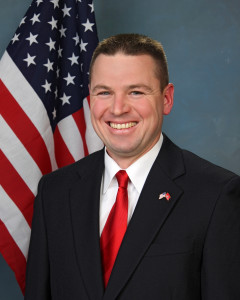ND leaders on EPA regulations: ‘Potential impact could be catastrophic’

By Rob Port | Watchdog.org North Dakota Bureau
CATASTROPHIC REGULATION: North Dakota Public Service Commissioner Brian Kalk, a Republican, says the potential impact of new emissions regulations proposed by the EPA “could be catastrophic.”
BISMARCK, N.D. — President Obama’s proposal to reduce national carbon emissions by 11 percent in North Dakota met with hostility from state leaders who suggested the regulations could be catastrophic, making the nation’s power grid less reliable and energy more expensive.
The regulations, which will undergo one year of public comment before taking effect, would require each state to comply with specific restrictions on carbon dioxide emissions for existing power plants. The national goal is to reduce emissions by 30 percent.
The proposed emission limits for North Dakota power plants would be 1,817 pounds of carbon dioxide per megawatt-hour by 2020, and 1,783 pounds per megawatt-hour by 2030, should the regulations become law.
Currently coal-fired power plants average about 2,250 pounds per megawatt-hour. The EPA has already been taking public comment on a proposed cap of 1,100 pounds of carbon dioxide emissions per megawatt-hour of electricity generated for new power plants.
The federal agency estimates national compliance costs for the regulations on existing power plant emissions will range from $5.4 billion to $7.4 billion annually beginning in 2020 before increasing to $7.3 billion to $8.8 billion annually beginning in 2030.
Economic impacts “could be catastrophic”
Public Service Commissioner Randy Christmann, a Republican, said much of the Midwest’s power comes from coal, making those in the region accustomed to the dependable and reasonably-priced electricity. He sees the new regulations causing price turmoil in the energy markets.
“As we shut down a select few coal plants or idle them back in order to meet the Democrats’ mandate, two things will have to happen,” he told Watchdog. “The coal plants will have to charge more for the power they do produce since their sales will be less but their fixed costs remain unchanged, and we will have to decorate our landscape with more wind turbines to replace that lost generation. Because the wind is not dependable, we will also need to add more natural gas peaking generation to run when the wind is not blowing.”
He said consumers will be saddled with the cost of wind farms, additional natural gas plants and higher prices for coal-generated power.
Fellow Public Service Commissioner Brian Kalk, also a Republican, agreed with Christmann’s assessment, saying the “potential impact could be catastrophic.”
“My concern, as always, is how these and other regulations impact system reliability and what impact will they have on both energy costs to consumers and businesses and on economic growth in North Dakota,” Kalk told Watchdog. “Any time you impose cumbersome regulations on an industry, it slows growth. With our economy growing, we need more, not less, energy.”
U.S. Rep. Kevin Cramer, a Republican, called the proposed regulations “extreme.”
“The EPA has reached a new level of irresponsibility in its reckless pursuit of an extreme environmental agenda which pushes the average energy consumer off to the wayside,” he said in a press release. “The high costs of these unprecedented regulations will be pushed onto the energy bills of citizens and businesses. It is astonishing how out of touch the Obama Administration is with the American people, many of whom can’t afford to pay more than they already do for electricity.”
“What will be there to keep the power on”
Jason Bohrer, president of North Dakota’s Lignite Energy Council, an industry group representing coal interests in the state, said demand for electrical power in the state is expected to increase by 209 percent in the next two decades. He noted coal was called upon to heat the state during the past winter’s ‘polar vortex.”
“The U.S. Department of Energy predicts that 20 percent of the country’s coal-fired generation capacity could be on the chopping block,” he said. “This begs the question, what will be there to keep the power on during the next cold snap or heat wave?”
Christmann says the loss of reliability is worse than the potential cost impacts of the regulations.
“Our system of the future is likely to be much less reliable than what we are accustomed to. Think of furnaces that do not work on the coldest nights and air conditioners that do not work on the hottest days,” he said. “Our reliable and affordable electricity is one of the key components that separate us from third world countries where people frequently die during adverse weather conditions.”
“Will do little to reduce carbon emissions”
Obama has described his goal of reducing carbon emissions as a national health issue.
“We don’t have to choose between the health of our economy and the health of our children,” he said in his weekly address Saturday. “As president and as a parent, I refuse to condemn our children to a planet that’s beyond fixing.”
But some leaders question whether this new proposal will have the impact the president suggests.
“The way to address emissions is not with a set of burdensome regulations that will prevent investment and shutdown power plants,” ” said North Dakota Sen. John Hoeven, a Republican, in a press release. “Instead, we need to encourage and empower private investment that will develop and deploy new technology to produce more energy with better environmental stewardship.”
Hoeven’s colleague, Democratic Sen. Heidi Heitkamp, agreed.
“These new EPA policies will produce minimal environmental benefits unless other countries also aggressively reduce emissions, to the detriment of their economies,” she said in a Wall Street Journal column co-authored by Sen. John Barrasso, a Wyoming Republican.
You can reach Rob Port at rport@watchdog.org







